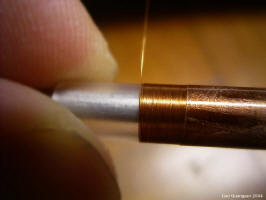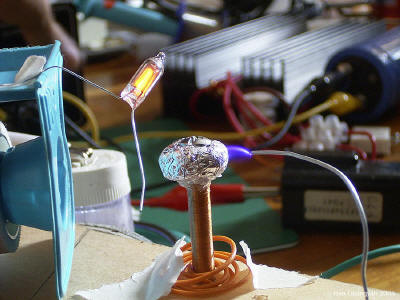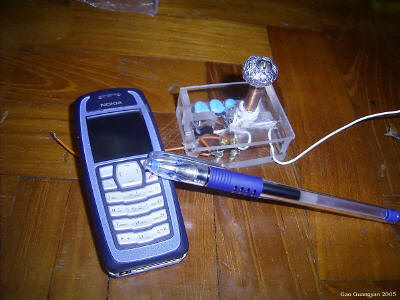Tesla Coil 3
A Rather Small Tesla Coil
|
Introduction
This project was born after I found and bought a
curiously thin AWG 40 (0.08mm) wire from an electronics shop. Having
achieved rather good results with my Tesla Coil
1 and Tesla Coil 2, I thought it would
be a great idea to build a ridiculously small tesla coil! I also
submitted this as part of a thread in the 4hv.org forums back in end
2004 / early 2005, when there was a little competition going on to build
the smallest Spark Gap Tesla Coil possible. I named this project ARSTC -
A Rather Small Tesla Coil.
[ Note] I always wanted to post a little page about this project,
and some 9.5 years later, I've finally done it! Perhaps one day I'll try
my hand at building another tiny coil sometime. Enjoy!
ARSTC Specifications (I modeled this is JavaTC some
9.5 years after it was constructed!):
- ~10kVDC input from a flyback
transformer
- ~5 x 29mm pen refill secondary
- Wound with ~330 turns of AWG 40
- 5 or 6 turns of normal 24AWG wire (primary)
- Four 680pF 2kV ceramic capacitors in series
- Approximately 6.9 x 14mm 'toroid'
- Just about 1cm sparks
- Secondary resonant fres: 20.4Mhz
- Primary resonant fres: 24Mhz
- Spark length - 10mm
Back then I didn't really do any modeling for the coil,
but the fact that it made ~10mm sparks was quite amazing, even though
the flyback transformer acting as the power source made bigger sparks
than the coil itself!
10 Dec 2004
A Rather Small Tesla Coil
December 2004
I started the project by finding the smallest secondary
form I could find. I originally wanted to use a pen as a coilform, but
that was too big, so I decided to use the inner tube of a Pilot G1 or G2
pen (I can't recall which one), but it was 5mm in diameter. Then with
the help of a magnifying glass, I starting winding the insanely thin
40AWG wire! The first time ended in disaster and I had to restart, but
the second time went well and I completed the coil in just around half
an hour.




With the secondary coil complete, I varnished it to
protect the coil, and set up some test primary coils as a
proof-of-concept. For the capacitor, I used a self-made Lynden Jar using
salt water, aluminum foil and a small glass vial. First light was
produced using simply my crocodile clips as the primary coil. For the
power supply, I simply used my flyback high voltage source. Needless
to say, I could not tell what the voltage or current was. Then I formed
a 'toroid' out of aluminium foil. But would it
work?

First light is always a milestone event! Even though
this coil produced only 1mm sparks, it was working as a Tesla Coil,
making sparks without electrical contact with the primary circuit!
However, I thought it was a bit ridiculous since the flyback power
supply was making 10mm sparks - 10x longer than the coil it was
powering!


I started tuning it by adding more primary turn, and the
result was a coil that made sparks about 5 to 6mm long. I eventually
settled for a cute-looking primary coil held in place with hot glue.
Finally, I used two brass screws as a spark gap! The coil now made 5-6mm
sparks.
29 January 2005
I had some spare ceramic capacitors lying around so I
thought that maybe I could try to improve the performance of the coil.



In addition, I added some more projection for the
secondary coil by shrink-wrapping it with clear heat-shrink. I used four
2kV 680pF ceramic capacitors as the resonant cap (in retrospect this was
just guesswork - I was lucky that the coil actually worked!), and a new
cylindrical primary was made via a few turns of wire and everything was
secured via hot glue. I did this to increasing coupling to the coil. How
would the new design fare?


Not only was it producing bigger sparks than before, it was also producing
a small but stronger electric field enough to illuminate neon bulbs a few centimeters
away with no difficulty. Compare how much brighter the neon bulb lights
up!

What I thought was especially nice was the extremely
delicate 20+Mhz spark forming at the top of the toroid, similar to that
from a flyback transformer, but very wispy and looked almost quiet (of
course with the buzz of the spark gap, I could not verify this). But it
was very fascinating for sure.
I submitted it to the forum's competition and I believe at
time of posting, was by far the smallest Tesla Coil. I believe that this
forum was at the time (and even today), the forum for Tesla Coils
(for English speakers), it could have been the smallest Tesla Coil in the
world! Someone soon built a very slightly smaller coil, but I am happy to
have got this working! Perhaps next time, I'll try building a tiny coil
like this, but with the power supply integrated together!
Back to main page
(c) Gao Guangyan 2025
Contact: loneoceans [at] gmail [dot] com |

